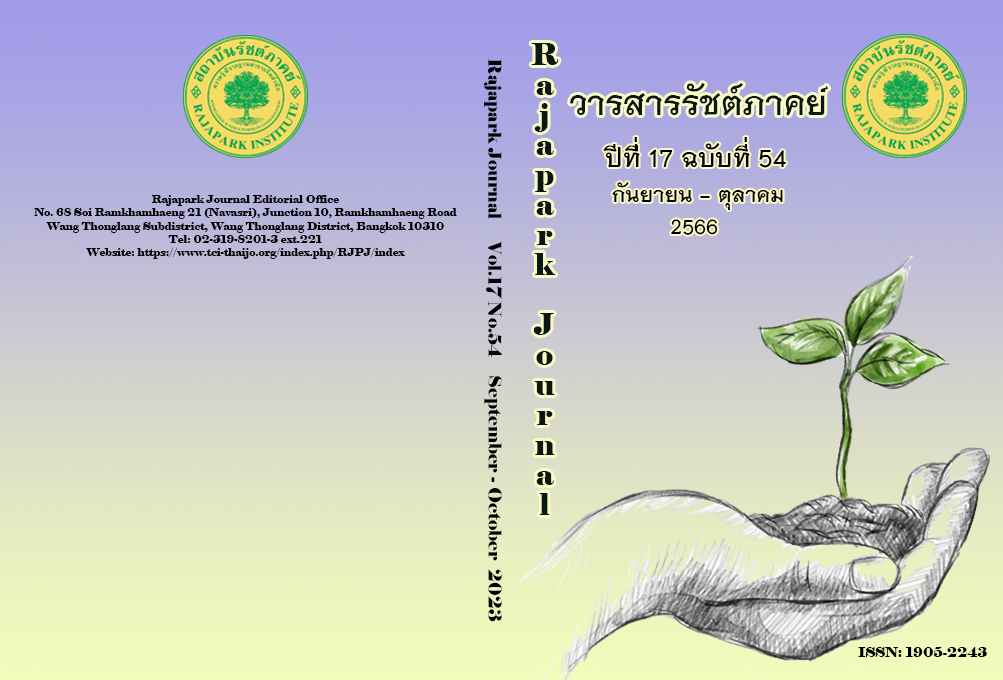อิทธิพลของการรับรู้คุณค่าและความคิดเห็นเชิงสังคมที่มีผลต่อกลยุทธ์การตลาดเชิงคุณค่าสินค้าที่ระลึกท้องถิ่น ในเขตภาคตะวันออกเฉียงเหนือตอนล่างของประเทศไทย
Main Article Content
บทคัดย่อ
บทความวิจัยนี้มีวัตถุประสงค์ เพื่อศึกษาความสัมพันธ์ของปัจจัยด้านการรับรู้คุณค่าและความคิดเห็นเชิงสังคมที่มีต่อกลยุทธ์การตลาดของสินค้าที่ระลึกท้องถิ่นในเขตภาคตะวันออกเฉียงเหนือตอนล่างของประเทศไทย ซึ่งเป็นการวิจัยเชิงปริมาณ โดยใช้แบบสอบถามในการเก็บรวบรวมข้อมูลจากนักท่องเที่ยวชาวไทยที่มีประสบการณ์การเดินทางท่องเที่ยวและซื้อสินค้าที่ระลึกท้องถิ่น กลุ่มตัวอย่างจำนวน 1,200 ราย วิเคราะห์ข้อมูลโดยใช้สถิติพรรณนาและสถิติอนุมานผ่านแบบจำลองสมการโครงสร้าง (SEM) ผลการวิจัยพบว่า ระดับการรับรู้คุณค่า ความคิดเห็นเชิงสังคมและกลยุทธ์การตลาดเชิงคุณค่าที่มีต่อสินค้าที่ระลึกท้องถิ่น ภาพรวมอยู่ในระดับมากที่สุด เมื่อวิเคราะห์ความสัมพันธ์ของปัจจัยที่ทำการศึกษาพบว่า การรับรู้คุณค่าของสินค้าที่ระลึกท้องถิ่นมีอิทธิพลทางบวกกับความคิดเห็นเชิงสังคมที่มีต่อสินค้าที่ระลึกท้องถิ่น ค่าน้ำหนักเท่ากับ 0.948 ในส่วนของการรับรู้คุณค่ามีอิทธิพลทางบวกต่อกลยุทธ์การตลาดเชิงคุณค่าของสินค้าที่ระลึกท้องถิ่น ค่าน้ำหนักเท่ากับ 0.227 และสุดท้ายความคิดเห็นเชิงสังคมมีอิทธิพลทางบวกต่อกลยุทธ์การตลาดเชิงคุณค่าของสินค้าที่ระลึกท้องถิ่น ค่าน้ำหนักเท่ากับ 0.744 โดยทุกความสัมพันธ์นั้นมีนัยสำคัญทางสถิติที่ระดับ 0.05 นอกจากนี้แบบจำลองที่พัฒนาขึ้นนั้นมีความสอดคล้องกลมกลืนกับข้อมูลเชิงประจักษ์ สามารถพยากรณ์ได้ระดับดีโดยมีค่าสหสัมพันธ์ (R2) เท่ากับ 0.927
Article Details

This work is licensed under a Creative Commons Attribution-NonCommercial-NoDerivatives 4.0 International License.
ทัศนะและความคิดเห็นที่ปรากฏในวารสาร ถือเป็นความรับผิดชอบของผู้เขียนบทความนั้น และไม่ถือเป็นทัศนะและความรับผิดชอบของกองบรรณาธิการ
References
Aliman, N. K., Hashim, S. M., Wahid, S. D. M., & Harudin, S. (2014). Tourist Expectation, Perceived Quality and Destination Image: Effects on Perceived Value and Satisfaction of Tourists Visiting Langkawi Island. Asian Journal of Business and Management, 2(3), 212-222. https://www.ajouronline.com/index.php/AJBM/article/view/1397
Ansari, F., Jeong, Y., Putri, I. A., & Kim, S. I. (2019). Sociopsychological Aspects of Butterfly Souvenir Purchasing Behavior at Bantimurung Bulusaraung National Park in Indonesia. Sustainability, 11(6), 1789. DOI:10.3390/su11061789
Bamroongboon, K., & Potiwan, P. (2021). The Development of Souvenirs to Represent the Local Identity of Maha Sarakham to Elevate Economic Value. Journal of Humanities and Social Sciences Mahasarakham University, 40(2), 7-24.
Department of Industrial Promotion. (2016). Thai Cultural Capital to Create the Thai Economy. Industrial Journal, 58, 5-8. https://e-journal.dip.go.th/dip/images/ejournal/fd2eaa1aedd740f4b4e32346220a000d.pdf
Diamantopoulos, A., Siguaw, J. A., & Siguaw, J. A. (2000). Introducing LISREL: A Guide for the Uninitiated. Sage.
Filipova, H. (2018). Marketing Strategies Regarding the Offer of Souvenirs in Tourism. Izvestia Journal of the Union of Scientists-Varna. Economic Sciences Series, 7(3), 84-90.
Hair, J. F., Anderson, R. E., Tatham, R. L., & Black, W. C. (1998). Multivariate Data Analysis (5th ed). Prentice Hall.
Hiranyachawalit, S. (2016). Souvenir Innovation for Cultural Capital. Executive Journal, 36(2), 14-23. https://so01.tci-thaijo.org/index.php/executivejournal/article/view/81344
Jamal, S. A., Othman, N. A., & Muhammad, N. M. N. (2011). Tourist Perceived Value in a Community-Based Homestay Visit: An Investigation into the Functional and Experiential Aspect of Value. Journal of Vacation Marketing, 17(1), 5-15. DOI:10.1177/1356766710391130
Kim, K. H., & Park, D. B. (2017). Relationships Among Perceived Value, Satisfaction, and Loyalty: Community-based Ecotourism in Korea. Journal of Travel & Tourism Marketing, 34(2), 171-191. DOI:10.1080/10548408.2016.1156609
Kumplanon, N., & Silpcharu, T. (2022). The Promotion of Ethical Marketing for Sustainable Growth in the Industrial Sector. Ph. D. in Social Sciences Journal, 12(1), 73-86. https://so05.tci-thaijo.org/index.php/phdssj/article/view/228515
Kusdibyo, L. (2016). Examining Souvenir Shopping Tourists" Behaviour Across Cultures. In Asia Tourism Forum 2016-the 12th Biennial Conference of Hospitality and Tourism Industry in Asia. Atlantis.
Likert, R. (1932). A Technique for the Measurement of Attitudes. Archives of psychology.
Luo, J., Dey, B. L., Yalkin, C., Sivarajah, U., Punjaisri, K., Huang, Y. A., & Yen, D. A. (2020). Millennial Chinese Consumers' Perceived Destination Brand Value. Journal of Business Research, 116, 655-665. https://doi.org/10.1016/j.jbusres.2018.06.015
Marzouki, S. Y. (2020). Studying the Vital Role of Souvenirs Industry as an Essential Component of Tourist Experience: A Case Study of the United Arab Emirates (UAE). Journal of Tourism, Hospitality and Sports, 46, 24-33.
Namahoot, K. S., & Laohavichien, T. (2018). Assessing the Intentions to Use Internet Banking: The Role of Perceived Risk and Trust as Mediating Factors. International Journal of Bank Marketing, 36(2), 256-276. DOI: 10.1108/IJBM-11-2016-0159
Nitichaowakul, T. (2016). Consumer’s Attitudes Towards Brand Image and Marketing Strategies of Souvenir Shop in Pattaya City, Chonburi Province. Modern Management Journal, 14(2), 105-114.
Pantaratorn, P., & Phondon, K. (2021). The Perceptions of Thai Millennial Generation Tourists on the Concept of Sustainable Tourism. Sripatum Review of Humanities and Social Sciences, 21(1), 89-104. https://so05.tci-thaijo.org/index.php/spurhs/article/view/240551
Penerliev, M. (2017). The Souvenir Industry as an Additional Tourist Activity. Quaestus Multidisciplinary Research Journal, (10), 67-72.
Polyorat, K., Unaprom, C., & Sirisuntorn, S. (2022). Brand Personality: An Application for Country Brand Personality. Journal of Chandrakasemsarn, 28(1), 93-108.
Pongpaibool, P. (2018). Thailand’s Creative Marketing Strategy Model for Souvenirs Based on the Perception of Border Country Tourists from Cambodia-Laos-Myanmar-Vietnam. Siam University.
Prajonsarn, S. (2020). Creation of Value and Value of Community-Based Tourism Through Souvenirs a Guide to Develop the Potential of Tourism Personnel for the Community. Buriram Rajabhat University. https://dspace.bru.ac.th/xmlui/bitstream/handle/123456789/6968/aw%20%E0%B8%AB%E0%B8%99%E0%B8%
Prasittirathasin, S. (2008). Multivariate Analysis Techniques for Research Social Science and Behavioral Sciences. Leaingcheing Publishing.
Ramseook-Munhurrun, P., Seebaluck, V. N., & Naidoo, P. (2015). Examining the Structural Relationships of Destination Image, Perceived Value, Tourist Satisfaction and Loyalty: Case of Mauritius. Procedia-Social and Behavioral Sciences, 175, 252-259.
Saibuator, S., & Snae Namahoot, K. (2019). Pattern of Behavioral Acceptance of Internationality in The Use of Smart Applications for Health of Gen X. Srinakharinwirot Business Journal, 10(2), 78-91.
Sakdasiroratana, A., & Lawphanthusakul, A. (2015). How to Develop Handicraft-Souvenir Business in the Context of Tourism. FEU Academic Review, 9(1), 30-36.
Schumacker, R. E., & Lomax, R. G. (2010). A Beginner’s Guide to Structural Equation Modeling (3rd ed). Lawrence Erlbaum Associates.
Silpcharu, T. (2017). Research and Statistical Analysis with SPSS and AMOS. Business R&D.
Sregongsang, S. (2018). Creative Tourism Activities Development in Bakchum Community, Nonkor Subdistrict, Sirinthorn District, Ubon Ratchathani Province. Journal of Liberal Arts, Ubon Ratchathani University, 14(2), 189-208.
Thaworn, P., Sinnarong, N., Sitthisatikuland, K., & Sumritsakun, C. (2022) The Causal Relationship Between Total Quality Management and Total Quality Environmental Quality Management Influences Corporate Sustainability Performance of the Manufacturing Industry in Thailand. Journal of Liberal Arts and Service Industry, 5(1), 274-282. https://so01.tci-thaijo.org /index.php/JLASI/article/view/253585
Tourism Authority of Thailand. (2021). Annual Report 2021. https://www.tat.or.th/th/about-tat/annual-report.
Yamane, T. (1973). Statistics: An Introductory Analysis (3rd ed.). Harper and Row.

